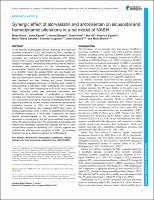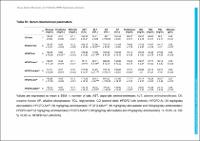| dc.contributor | Vall d'Hebron Barcelona Hospital Campus |
| dc.contributor.author | Bravo Garmendia, Miren |
| dc.contributor.author | Raurell Saborit, Immaculada |
| dc.contributor.author | Barbera Belles, Aurora |
| dc.contributor.author | Hide Alferez, Diana |
| dc.contributor.author | Estrella Gonzalez, Federico |
| dc.contributor.author | Salcedo Allende, Maria Teresa |
| dc.contributor.author | Genescà Ferrer, Joan |
| dc.contributor.author | Gil Soler, Mar |
| dc.contributor.author | Martell Pérez-Alcalde, Maria |
| dc.contributor.author | Augustin Recio, Salvador |
| dc.date.accessioned | 2022-01-12T11:41:52Z |
| dc.date.available | 2022-01-12T11:41:52Z |
| dc.date.issued | 2021-05 |
| dc.identifier.citation | Bravo M, Raurell I, Barberá A, Hide D, Gil M, Estrella F, et al. Synergic effect of atorvastatin and ambrisentan on sinusoidal and hemodynamic alterations in a rat model of NASH. Dis Model Mech. 2021 May;14(5):dmm048884. |
| dc.identifier.issn | 1754-8403 |
| dc.identifier.uri | https://hdl.handle.net/11351/6765 |
| dc.description | Ambrisentan; Endothelin-1; Hepatic stellate cells |
| dc.description.abstract | In non-alcoholic steatohepatitis (NASH), decreased nitric oxide and increased endothelin-1 (ET-1, also known as EDN1) released by sinusoidal endothelial cells (LSEC) induce hepatic stellate cell (HSC) contraction and contribute to portal hypertension (PH). Statins improve LSEC function, and ambrisentan is a selective endothelin-receptor-A antagonist. We aimed to analyse the combined effects of atorvastatin and ambrisentan on liver histopathology and hemodynamics, together with assessing the underlying mechanism in a rat NASH model. Diet-induced NASH rats were treated with atorvastatin (10 mg/kg/day), ambrisentan (30 mg/kg/day or 2 mg/kg/day) or a combination of both for 2 weeks. Hemodynamic parameters were registered and liver histology and serum biochemical determinations analysed. Expression of proteins were studied by immunoblotting. Conditioned media experiments were performed with LSEC. HSCs were characterized by RT-PCR, and a collagen lattice contraction assay was performed. Atorvastatin and ambrisentan act synergistically in combination to completely normalize liver hemodynamics and reverse histological NASH by 75%. Atorvastatin reversed the sinusoidal contractile phenotype, thus improving endothelial function, whereas ambrisentan prevented the contractile response in HSCs by blocking ET-1 response. Additionally, ambrisentan also increased eNOS (also known as Nos3) phosphorylation levels in LSEC, via facilitating the stimulation of endothelin-receptor-B in these cells. Furthermore, the serum alanine aminotransferase of the combined treatment group decreased to normal levels, and this group exhibited a restoration of the HSC quiescent phenotype. The combination of atorvastatin and ambrisentan remarkably improves liver histology and PH in a diet-induced NASH model. By recovering LSEC function, together with inhibiting the activation and contraction of HSC, this combined treatment may be an effective treatment for NASH patients. |
| dc.language.iso | eng |
| dc.publisher | Company Biologists |
| dc.relation.ispartofseries | Disease Models & Mechanisms;14(5) |
| dc.rights | Attribution 4.0 International |
| dc.rights.uri | http://creativecommons.org/licenses/by/4.0/ |
| dc.source | Scientia |
| dc.subject | Fetge - Malalties - Tractament |
| dc.subject | Rates |
| dc.subject.mesh | Liver Diseases |
| dc.subject.mesh | /drug therapy |
| dc.subject.mesh | Rats |
| dc.title | Synergic effect of atorvastatin and ambrisentan on sinusoidal and hemodynamic alterations in a rat model of NASH |
| dc.type | info:eu-repo/semantics/article |
| dc.identifier.doi | 10.1242/dmm.048884 |
| dc.subject.decs | enfermedades hepáticas |
| dc.subject.decs | /farmacoterapia |
| dc.subject.decs | ratas |
| dc.relation.publishversion | https://doi.org/10.1242/dmm.048884 |
| dc.type.version | info:eu-repo/semantics/publishedVersion |
| dc.audience | Professionals |
| dc.contributor.organismes | Institut Català de la Salut |
| dc.contributor.authoraffiliation | [Bravo M, Barberá A, Gil M, Estrella F] Unitat del Fetge, Servei de Medicina Interna, Vall d’Hebron Hospital Universitari, Barcelona, Spain. Vall d’Hebron Institut de Recerca (VHIR), Barcelona, Spain. Universitat Autònoma de Barcelona, Bellaterra, Spain. [Raurell I, Hide D, Augustin S, Genescà J, Martell M] Unitat del Fetge, Servei de Medicina Interna, Vall d’Hebron Hospital Universitari, Barcelona, Spain. Vall d’Hebron Institut de Recerca (VHIR), Barcelona, Spain. Universitat Autònoma de Barcelona, Bellaterra, Spain. Centro de Investigación Biomédica en Red de Enfermedades Hepáticas y Digestivas (CIBEREHD), Instituto de Salud Carlos III, Madrid 28029, Spain. [Salcedo MT] Servei de Patologia, Vall d’Hebron Hospital Universitari, Barcelona, Spain |
| dc.identifier.pmid | 34014280 |
| dc.identifier.wos | 000663756700006 |
| dc.relation.projectid | info:eu-repo/grantAgreement/ES/PE2013-2016/PI18%2F00947 |
| dc.relation.projectid | info:eu-repo/grantAgreement/ES/PE2013-2016/PI17%2F00754 |
| dc.relation.projectid | info:eu-repo/grantAgreement/ES/PE2013-2016/AC18%2F00033 |
| dc.rights.accessrights | info:eu-repo/semantics/openAccess |


